Interview: The Films of Ruth Lingford
Ruth Lingford has been a notable presence in the world of animation since the early nineties, working with the RCA, NFTS, Animate Projects and Shynola among others. A recent recipient of the Harvard Film Study Center Fellowship, her latest animated film, Little Deaths is an exploration of the vastly different physical and emotional interpretations of one of life’s most fundamental and seemingly universal experiences. Set against an auditory backdrop of interview snippets wherein contributors articulate their take on sexual climax, the animation itself is an artfully interwoven visual stream-of-consciousness procession, peppered by linear moments, anatomical explorations and dry wit. I talked with her about the film’s origins, execution and reception, along with the atypical path of her career to date.
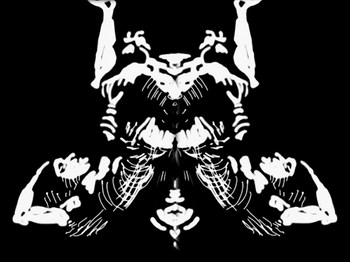
Little Deaths (©2010 Ruth Lingford)
How did your most recent film come together conceptually?
I’d been working for some time on a documentary called Secrecy, directed by two of my colleagues at Harvard, which was a film about government secrecy. The animation’s role was to kind of be the unconscious of the film and to try and look at what secrecy means to humans. A lot of that was images of Adam and Eve, the tree of knowledge and sex. I ended up doing a lot of animation that wasn’t used in the end, some of which I liked. I was a bit embarrassed having been at Harvard a few years and not having made a film of my own, so I was thinking of ways to use this leftover footage to make a quick, two-minute film. I hit on the idea of taping interviews of people and asking them to describe orgasm, thinking “obviously you can’t describe orgasm, so people will run out of words”. My plan was to edit together the moments where people ran out of words accompanied by vague sexual images, and that would be the film – but when I started doing the interviews I found that nobody ran out of words at all. I live in Cambridge, Massachusetts, which is the home of Harvard, MIT and a lot of very clever and articulate people, so that may be why – but I found people were really wanting to talk about it. People would say “I’ve never put this into words before”, then make a big attempt to do so, getting really interested in what their own experience was, and of course I got quite interested in the differences and the similarities between people. So then it became a quite different project and the animation had to start from scratch.

Little Deaths (©2010 Ruth Lingford)
How did you go about approaching people to contribute their own experiences to the film?
I would say about 95% of the people who get this (FSC-Harvard) fellowship are documentary makers, so my peer group didn’t really understand what I was doing. There was a lot of pressure to be more multi-cultural, which would have been great if I’d had more time and more money. I’d have loved to have gone to the Muslim countries and asked people, but basically the people I asked were either people I knew or friends of friends, so in a way they were slightly pre-selected. Although within that there was a wide range of people – male, female, gay, straight and one male-to-female transsexual – though not such a wide range of ages, probably the oldest would’ve been late-fifties, and they were all American or European. It would take the form of a conversation but I’d ask the same sort of questions which I decided to actually put on screen, both to give some structure to the film and to encourage the audience to ask the questions of themselves; “What’s it like?”, “What do you see?” – because a lot of people talk about visual imagery during the moment of orgasm, “What’s it like afterwards?”, “What does it mean to you?” – those tended to be the basic questions.
So once you had all that recorded, what was the process for selecting which dialogue would go in?
Well, that was very tricky. Actually some of the best stuff was jettisoned because it just wouldn’t form sound bites, as it was a short film there had to be stuff that got across quickly. I wanted stuff that would represent the main themes I’d found were coming up again and again, but that was tough. I did intend to – and may still – use the rest of the material for something else. I’d thought of either making some sort of gallery installation where you could listen in to the whole conversations in various contexts, or something online and interactive where you could choose conversations to listen to.
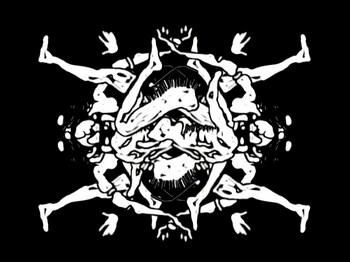
Little Deaths (©2010 Ruth Lingford)
It does seem like the kind of project that would lend itself to something installation-based or interactive-based.
Yeah, you wouldn’t necessarily want to sit down and listen to thirty hours of stuff but it might be interesting for people to just choose little bits to listen in to.
Even considering the expected range of responses from different people involved, was there anything that caught you off-guard?
Maybe one of my surprises about the film is how sad it is, in a way. There’s a melancholy in the film which I wasn’t necessarily expecting.
I do remember one comment that kind of hit me and seemed to come from nowhere, where one guy refers to it as the ‘illusion of not being on your own’. It generated an odd moment of introspection, in that I’d never really thought about it in a sad way before.
It fascinates me that the way people generally describe orgasm is as an absence, an absence of experience, a temporary absence of self, almost a negation of the self in those moments. A ceasing to be, and yet for most people it’s an overwhelmingly positive experience, and that seems kind of odd for such a non-experience in a way, that it was so valued while at the same time having very melancholy overtones.
Also elements of humour in places.
Yeah, there were funny things and people would make themselves laugh with their own realising how weird the stuff that went through their heads was. One of the interesting things is how many things are almost completely universal, and then you’ll get these weird, idiosyncratic concepts like broccoli or modern homes. People don’t know which are the things that happen to everybody and which are the things that are just them.
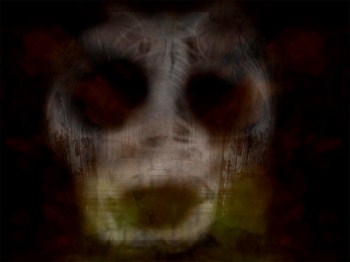
Little Deaths (©2010 Ruth Lingford)
Are those moments of levity something you consciously tried to incorporate, or did they present themselves organically while the film came together?
I suppose the naughty, directorial thing I was doing was making the contrasts, so you’d have one person “It’s like the meeting of the spiritual and the material…” et cetera, then someone else saying “It’s like wanting to pee”. So those sorts of juxtapositions I’d found very interesting and potentially funny, so I wanted to have those. But some things, the humour almost comes out of surprise. I also wanted to capture the bathos – people can get quite grandiose talking about their orgasms but then there are moments where that’s punctured.
Did the animation come after the soundtrack was put together, or did you edit the sound to fit the visuals?
The sound came first, and originally the film was much wordier. It’s now eleven minutes and it had been a bit more, about thirteen minutes of absolutely non-stop talking. I got very stuck and didn’t see how I could get rid of any of the dialogue, it all seemed sort of essential. But then every time I’d cut some dialogue out it would get better; air would start to flow through the film, so gradually I chipped away at it. What I’ve found with using voice in films is that you have the time to listen to it but you need more time to process it and compare it to your own experience. If you have one voice after another relentlessly, then the audience won’t really process anything and will forget what they’ve heard I think, or switch off.
This film, alongside two of your earlier works What She Wants (1994) and Pleasures of War (1998) seem to all explore a more private,psychological side of sexuality that isn’t as depicted in films, TV and literature,albeit dealing with it in quite different ways. ‘Pleasures…’, for example, going into the correlations between violence and the sexual impulse. Based on the way they’ve been received and considering the span of time between them,have you noticed any change in audience attitudes toward that kind of subject matter?
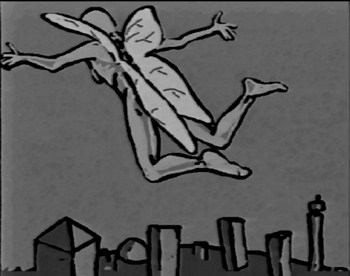
What She Wants (©1994 Ruth Lingford)
With all those films there’s this weird sort of dichotomy, some people behave as if it’s “just animation, so how could it be shocking?” When I had the screening for Pleasures of War someone insisted on taking her seven-year-old child in to see this film, which I thought was bordering on child abuse, really. People do behave as if it can’t do any damage because its animation, which is the same as saying it can’t really mean anything. So people can be very blasé in a way about the sexual content. I’ve also had the opposite experience – with this film I had a colleague who refused to watch it because he knew it was about orgasms and he said “I’m not comfortable with that content”, which really surprised me. The content is uncomfortable for some people and I can’t say that it’s differed in terms of time, really.
Have you picked up on any change in audience response to abstract animation in general?
My films aren’t strictly abstract, though What She Wants and Little Deaths wouldn’t be considered narrative as such. They have figurative content, you can see what’s going on, but they’re kind of non-narrative I’d say, rather than abstract.
Death and the Mother (1997) stands out as a fairly narrative film…
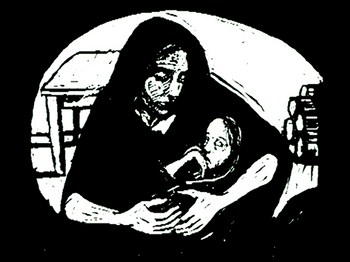
Death and the Mother (©1997 Ruth Lingford)
Pleasures of War was narrative too, although not too tightly. I don’t know if there are differences… Little Deaths is the first film I’ve made in America, and the thing I did notice is that people generally are much kinder to each other over there. When I was going through the process of making this film everyone would go “Wow, that’s so awesome!”. So I would think “Yeah, it’s not ‘awesome’ but it’s probably okay“. Then I brought it back to England and people just cut me to pieces with it, which was kind of hurtful but also very useful. I think there’s a more rigorous, more muscular critical engagement with animation in Britain.
I’m always intrigued by people working in animation – or really any creative or artistic industry – who entered into it later in life. Was there any particular motivation behind you making that career change at that point in your life?
I’ve been telling the Harvard students this story and they love it, because they’re terrified that they have to have this career path from the word ‘go’, one they mustn’t deviate from; My life has not been like that. I first trained as an occupational therapist – I was working with psychiatric patients and elderly, mentally ill people. It made a difference, it was an interesting job, not like nursing where you do the terrible hours, so it was in many ways a perfect job…but I think I wasn’t very good at it, to be honest. I remember working with depressed people, having to get them out of bed to do various activities and I found it very wearing to pour that energy into a big black pit. Of course working with the elderly mentally ill, where nobody’s getting better, that kind of saps your energy as well. Something wasn’t quite working for me. When the kids were small my friends were going to a life-drawing class – I’d done a year at art school when I’d left high school, but hadn’t done anything serious since. So I went to this life class, mainly because my friends were going and also because they had a nursery for kids. I just happened to meet this particularly inspiring teacher there, started taking it more seriously and then went back to art school part-time. Middlesex had just started its modular scheme, which made it pretty ideal for me, working part-time and having the kids. I was painting, drawing, etching, sculpting and I got into animation kind of by accident, as a by-product of frustration; when you’re painting, the new layers of paint efface the old layers, so I’d wanted to take some record of that. I found an old standard-8 camera for five pounds at a junk stall and set that up to record the process of a painting. That took up about three seconds and I had two or three minutes of film left, so I did some experiments and sent it off to Belgium to get processed, as you had to do in those days. When it came back I had this amazing experience of “This is what I want to do when I grow up!” It was just so exciting to see my drawings move and also to find that, in a weird way, nothing is wasted. When I was studying occupational therapy a lot of what you do is breaking down activities and looking at what movements are involved. You also learn a lot of anatomy and all that stuff seemed to help make me able to understand animation and drawing, I think. So when these animated drawings and sketches and experiments came back, they worked in a way that was incredibly exciting and addictive and I wanted to do more of it. I always used to be a knitter, so that sort of obsessive-compulsive ability to do repetitive actions helped me as an animator, I would sit and draw for hours and hours and hours.
It’s a good thing to have in your corner.
Yeah, it really suited me. It was just great to be in a non-caring profession as well, although one of my first jobs on leaving college was animating medical diagrams, so whatever you’ve done before tends to feed into you work.
Were there any particular practitioners of art or animation that you held in high regard and considered influential?
A friend of mine dragged me along to one of the London film festivals a few years before I’d ever gotten interested, and I saw Hedgehog In The Fog (Yuri Norstein, 1975) which I thought was beautiful. I saw some other interesting films but oddly enough the film that really made me go “Oh wow, I could do this” was a film called Strangers In Paradise (Andy Stavely, 1987), which was a Royal College graduation film. It’s a lovely, quirky, 3D puppet film made with lots of fabric and textiles, it has a kind of home-made, knitted look about it, although it wasn’t actually knitted. It just had a quality in it of some individuality, some sparkiness. I think sometimes when you see very beautiful masterpieces you can admire them, but you can’t get that feeling of identification, though later on when I started animating Yuri Norstein and Caroline Leaf were very influential in terms of the humanism of their work. Neither of them were obsessed with technical bravura, they were interested in the minutiae of what people were like, how people behave, how people’s behaviour illuminates their interior lives. I guess interiority is important for me in relation to animation.
My impression is that pretty much from the outset you’ve used a lot of digital processes to execute your films, although the visual style is kind of traditional in itself.
I was at the Royal College of Art from 1990-1992, when computers weren’t being used in the animation department, so I worked just on paper. They invited people from all the departments to do a short, three-day course on the computers – that was clunky at the time but it was kind of interesting. I certainly didn’t instantly think of myself as a computer animator, but when I left college I no longer had access to the rostrum camera and the lights and everything. We did have a home computer, an Amiga with half a megabyte of memory, so out of necessity I did some experiments to see if it was possible to animate on this computer. We had to upgrade to a full megabyte of memory and I developed this technique which seemed very obvious to me, and it wasn’t until later that I realised I had been kind of innovating a way of animating, using a program called Deluxe Paint. I now mostly animate using Corel Painter which is not exactly state-of-the-art, it’s also very clunky but has what I need, I like the brushes and it has a light table feature which is intuitively like working on paper.
One of your films for Animate Projects, The Old Fools (2002), is unique in that it uses a poem as its backdrop. Did that change the way you approached making the film, and what are your thoughts on the relationship between poetry and animation?
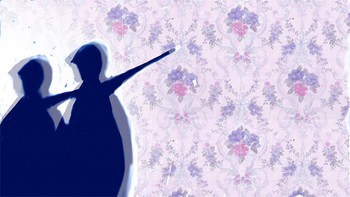
The Old Fools (©2002 Ruth Lingford)
While I was making that film my aim was very much to expose this poem that I’d never seen before and thought was wonderful. Philip Larkin wrote it when his mother was in an old people’s home and I first heard it when my father was in an old people’s home and the tone of it seemed so subtle and right. I just thought “This is amazing, I want to air this poem”, so because of that I made certain decisions like keeping the poem in its entirety and keeping the visuals rather quiet in relation to my normal visuals, less in-your-face somehow, much slower so that people could actually hear the poem rather than be distracted from it. A criticism of the film is that it’s maybe over-illustrative, it’s over subservient to the poem and it might have been better for the film if I’d cut verses out of the poem or faded it down and then back up, but I did feel committed to actually showcasing it entirely. I think poetry and animation have a really interesting relationship to each other, they’re both very compressed forms, very metaphoric and they have this way of colliding familiar elements in order to get new thoughts, new ideas. It seems to me that there’s some basic parallel between morphing one thing into another and placing words together to create new meaning. I think the conjunction of poetry and animation is a very useful one because they both seem to have got caught in various corners culturally; poetry’s in the ‘serious’ corner even when it’s funny, while animation’s in the ‘funny’ corner even when it’s serious. I think having a mix of the two is kind of useful, it helps to flow a bit of air around our expectations of both forms, I think.
I also was curious about your overall experiences with the Animate Projects scheme…
It absolutely was what gave me my career, because when I left college at that point it was pre-computers, so the work that was on offer was basically painting and tracing which I was incredibly bad at. One place apparently kept the cels I’d painted as an example of what not to do for the next people, so it was clear I wasn’t going to make a living in that part of the animation industry. In fact, I was fired from that job on the same day that I got my Animate grant to make What She Wants, so I was able to skip to being a director and developing my own voice. I’m really very grateful for that, I’m just so sad it’s no longer there, even though I think there were more really dreadful films that came out of the Animate scheme than good ones. That’s how it works, if you’re going to take risks some of the stuff’s going to be bad, but if you need everything to be totally successful you’re not going to get any innovation. I was on the panel at least once as well, and it’s tough because you’d get new people that you wanted to support, and then you’d get much more established animators going for the same little bits of money, which seemed crazy. It seemed like there should have been a separate fund for new people rather than having them compete with the Quay Brothers, say, for tiny pots of money.
So right now you’re based at Harvard, can you talk a little bit about your role there and how it came to be?
In 2005 I went there to do a year as a visiting instructor. They’ve always had, since the sixties, people in for a year or two at a time as visitors and I loved it so much that I made it clear I wanted to stay. The job I have is called Professor of the Practice of Animation which means I just teach one class a semester, while the rest of the time I’m doing my own work, which is pretty sweet. It’s a setup I don’t think I could get anything like in Britain. Harvard is a liberal arts education, so people don’t go there specifically to be filmmakers or artists, but there are enough serious students who want to give their time to it to make life really interesting there as a teacher. Mostly I’m teaching people who will probably only ever do one or two animation classes before going on to do other things but every year there’s one or two really serious animation students who go on to animation in some way, and it’s actually a really nice mix. It’s really stimulating having students from a whole range of different disciplines bringing their ways of thinking and their interest into animation, and they’re smart and they work hard, and they’re choosing to do it, so they love it. It’s probably the easiest sort of teaching there is – I’ve also taught at the Royal College of Art and the National Film School which are very high-end postgraduate courses, and that was great as well. Obviously it’s very rare to get the serious concentration on a film that you get in one of those places, but I’m always impressed by how much my students will achieve in very little time, alongside all their other subjects. It’s kind of amazing that they make any films at all, and some of the films are really good. Two ex-students are at the National Film School doing their master’s degrees there, and one who’s studying at the Royal College this fall I think, so it’s nice to see them carrying on.
So what sort of future plans do you have in regard to Little Deaths and also any other planned projects on the horizon?
Over the summer I’m making a music video with some friends of mine, really just as a chance to experiment and play and keep working, then when I go back in September I’m going to start a sort of companion piece to Little Deaths where I’m going to be taping interviews with people talking about spiritual experience.
Little Deaths won for Best Experimental/Abstract Animation at the 2010 Ottawa Animation Festival and received a Special Mention at the 2011 London Short Film Festival. Ruth Lingford’s earlier work What She Wants is available as part of Animate’s book/DVD set Rethinking Animation


